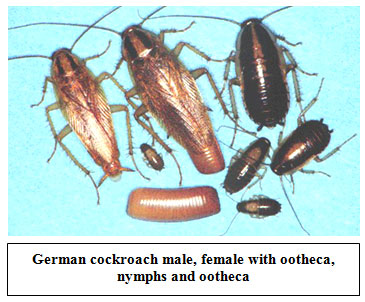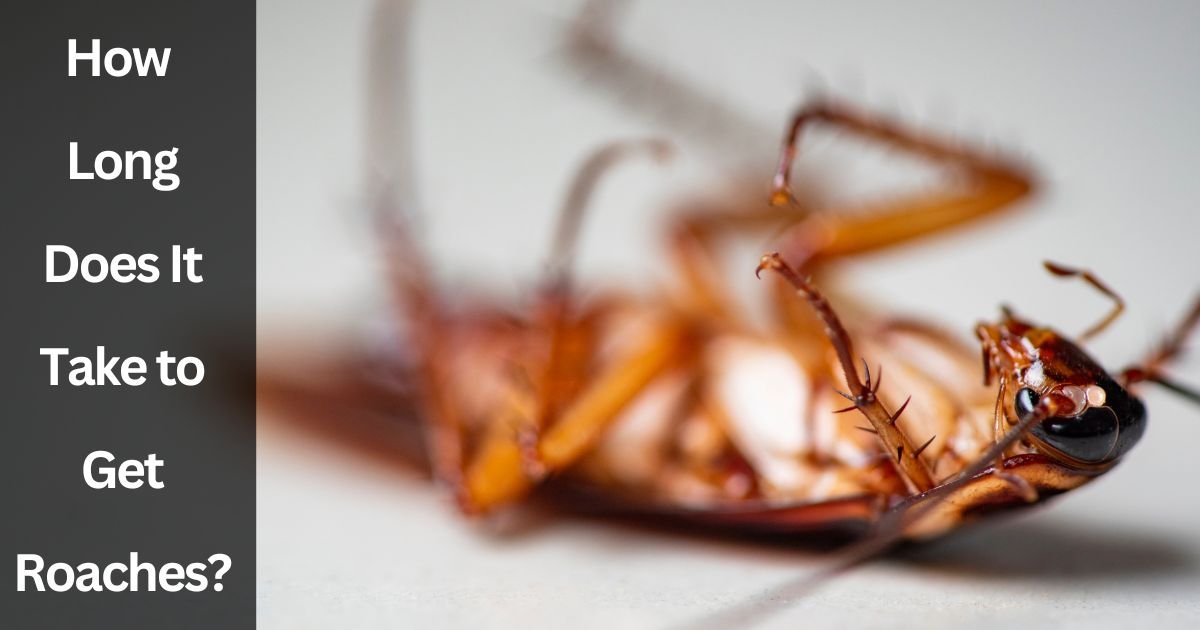The time it takes to get roaches can vary, but an infestation can begin in as little as a week. Ideal conditions allow rapid roach population growth.
Cockroaches are highly resilient pests that can invade homes or businesses swiftly, often without immediate detection. They proliferate quickly in environments that provide food, warmth, moisture, and shelter. Even a clean household is not immune, as roaches can hitch a ride inside through grocery bags, boxes, and second-hand appliances or furniture.
Discovering a single roach often indicates a larger hidden infestation, as these pests are typically nocturnal and avoid light. Early intervention is crucial to prevent the exponential growth of a roach population, which under optimum conditions, can expand from a few individuals to a full-blown infestation in a remarkably short period. Regular cleaning, proper food storage, and sealing entry points are key preventive measures to avoid these unwelcome house guests.

Credit: www.idph.state.il.us
An Unwelcome Surprise: Roach Encounters
Discovering roaches in your home can start as an innocent flicker of movement in the corner of your eye. That small sighting quickly turns into a clear sign o
f an infestation. This post will guide you through identifying the first signs of these unwelcome visitors and how to confirm their presence in your space.
First Signs Of Trouble
The journey from one roach to an infestation can be quicker than you think. Rushes of movement at night and strange smells are clues. You might notice tiny roach droppings that look like coffee grounds. Check dark, damp areas like under sinks and behind appliances. These pests prefer warmth, darkness, and moisture.
- Quick scurrying when lights turn on
- Oily odors lingering in your kitchen or bathroom
- Fecal spots or smear marks around corners and crevices
Identifying Roach Presence
A single roach often means more hide out of sight. Look for telltale signs to confirm their presence.
Start with a flashlight search. Check under the sink, in drawer corners, and behind the fridge. Eggs or shed skins indicate a growing problem. Roaches leave dark, peppercorn-like eggs called oothecae. Finding one means it’s time to act.
Roaches also have a distinctive smell. Sweet and musty, this odor is not to be ignored. Listen for rustling in quiet hours. These sounds can betray their nightly activities.

Credit: www.gogreenpestcontrol.com
Roaches’ Rapid Reproduction Rates
Cockroaches are infamous for their survival skills and rapid reproduction rates. An infestation can escalate quickly due to their ability to multiply at astonishing speeds. Understanding the breeding cycle of these pests is crucial for effective control and prevention strategies.
Lifecycle Of A Cockroach
A cockroach’s life begins from an egg. The lifecycle stages are egg, nymph, and adult. The egg stage is hardy, protecting the future generation. Nymphs resemble adults but are smaller and lack wings. After several molts, they become reproductive adults. A single roach can go from egg to adult in as little as a few months.
- Egg: Inside a protective case called an ootheca.
- Nymph: Immature stage, grows through molting.
- Adult: Fully grown, capable of reproduction.
Breeding Capabilities And Time Frames
The breeding capabilities of cockroaches are alarming. A single female roach produces hundreds of offspring in her lifetime. The German cockroach, one of the most common household pests, is particularly prolific.
| Species | Eggs per Ootheca | Oothecae per Year | Offspring per Year |
|---|---|---|---|
| German Cockroach | 30-40 | 4-6 | Up to 240 |
| American Cockroach | 14-16 | 6-14 | Up to 224 |
Factors such as environment and species, affect breeding timelines. Optimal conditions speed up the process, leading to faster infestations. Cockroaches can breed all year round in warm, humid environments. Lack of predators and access to food contribute to their population growth.
Factors Influencing Infestation Speed
If you’re dealing with roaches, you might wonder how quickly an infestation can occur. Several key factors play a role in the speed at which these pests can take over your space. Understanding these elements can help you tackle the infestation more effectively.
Availability Of Food Sources
Rapid roach infestations often hinge on the availability of food. Roaches are scavengers, thriving on crumbs, garbage, and even pet food. Leaving food out or not sealing it properly invites roaches to feast and stay.
- Keep kitchen surfaces clean of crumbs and spills.
- Store food in airtight containers to deter roaches.
- Dispose of garbage regularly and use cans with tight-fitting lids.
Hiding Places And Clutter
Roaches love to hide in clutter. Stacks of paper, boxes, and general disarray provide perfect hiding spots. Reducing clutter not only discourages roaches but also makes it easier to spot signs of an infestation.
- Declutter regularly, focusing on stacks of paper or cardboard.
- Inspect and clear out seldom-used areas like storage rooms.
- Fix any water leaks, as moisture attracts roaches.
Temperature And Humidity Conditions
Roaches thrive in warm and moist environments. They multiply faster when the conditions are just right. Maintain a dryer and cooler home to slow down their reproduction.
| Condition | Impact on Roaches |
|---|---|
| High Temperature | Accelerates growth and reproduction |
| High Humidity | Creates ideal breeding conditions |
| Low Temperature | Slows down or stops breeding cycle |

Credit: www.actionpest.com
Hitchhiking Roaches: Unseen Invaders
Rapid spread of roaches often surprises homeowners. These pests are hitchhikers, traveling unnoticed in everyday items. Discover how quickly they can infiltrate.
Transport Through Packages And Luggage
Packages may hide roaches, introducing them to your home. Roaches find cardboard inviting. They lay eggs within the creases. When packages arrive, inspect for these unwelcome guests.
Luggage can also be a culprit. After travel, it’s crucial to check bags. They might nestle in clothing or toiletries. A single hitchhiker can start an infestation.
Spread From Neighboring Areas
Roches cross over from adjacent properties. Shared walls, like those in apartments, make it easy. Look for gaps or holes. Seal them to keep these pests out.
Roaches travel through ducts and pipes. Regular maintenance helps. Use covers on drains. Keep spaces clean and monitor for signs of these invaders.
Human Contribution To Infestations
Human Contribution to Infestations often determines how quickly roaches become an issue. Many actions or inactions by people pave the way for roach populations to flourish. Understanding and addressing these contributions can significantly reduce the chances of a roach infestation.
Neglected Cleanliness
Routine cleaning prevents roaches from settling in. Not cleaning often invites these pests. Roaches thrive in mess, seeking shelter in clutter. Regular vacuuming, dusting, and decluttering are critical in keeping them away. Make a habit of:
- Wiping surfaces after every use
- Disposing of trash regularly
- Maintaining a clean and tidy home environment
Unattended Food And Waste
Leftover food and waste offer roaches ample resources to survive. Uncovered food is an open invitation. Moreover, roaches can subsist on tiny crumbs. To prevent these uninvited guests, one should:
- Seal food containers tightly
- Clear away food remnants promptly after meals
- Regularly empty waste bins and clean receptacles
The Timeline Of An Infestation
Understanding the stages of a cockroach infestation can be crucial. It helps identify and control the problem early. Cockroaches are not just uninvited guests; they can multiply rapidly. Let’s dive into the timeline to see how a minor issue can turn into a severe infestation.
Initial Infiltration
It starts with a few roaches. They slip in through cracks, vents, or hitch a ride on groceries. A single female carrying eggs can signal the start of an infestation. Conditions like warmth, moisture, and available food can lure them in.
Exponential Population Growth
- Within weeks, roaches can breed exponentially.
- A pair may produce hundreds of offspring in a year.
- Roaches mature quickly, and new generations continue the cycle.
The rapid increase is often unseen as roaches are nocturnal and elusive.
Established Colonies
Eventually, sightings become more common. Droppings, egg cases, and shed skins appear. It’s a sign of an established colony. By this point, the roach population may be in the thousands. Professional pest control becomes critical to address the problem.
| Stage | Time Frame | Signs |
|---|---|---|
| Initial Entry | Day 1 | First sighting, droppings |
| Population Growth | Weeks 2-4 | Egg cases, nymphs |
| Colony Establishment | Months 2+ | Visible roaches, heavy infestation signs |
Detection And Prevention Strategies
Cockroaches can sneak into homes without notice. Knowing how to detect and prevent them is key. Learn to stop roaches before they settle in.
Routine Inspections
Regular checks are vital to spot roaches early. Look for signs like droppings, egg casings, or a musty scent. Use a flashlight to search hidden areas. Focus on kitchens, bathrooms, and basements. Early detection stops infestations.
Proactive Sanitation Measures
- Keep kitchens clean; wipe surfaces daily.
- Dispose of garbage regularly and seal trash cans.
- Avoid leaving food out; store in sealed containers.
- Clean spills and crumbs promptly to discourage roaches.
Securing Entry Points
Seal cracks and crevices to deny roaches access. Install door sweeps. Fix window screens. Check pipes and vents. These steps help keep roaches outside.
| Area | Action | Benefit |
|---|---|---|
| Kitchen | Seal openings around pipes | Blocks common roach pathways |
| Bathroom | Repair leaky faucets | Removes water source for roaches |
| Exteriors | Seal gaps in foundation | Prevents entry from outside |
Professional Intervention: When And Why
Encountering roaches at home can trigger alarm and distress. Simply keeping your space clean may not always be enough to keep these pests at bay. There’s a crucial juncture where DIY solutions fall short and professional intervention becomes essential.
Determining The Need For Experts
Identifying a cockroach problem requires swift action. If you spot one, there are likely many more hiding. Expert intervention is necessary when:
- Infestation signs persist despite common home treatments.
- You find cockroach nests or large amounts of droppings.
- Allergies or asthma in your home worsen due to these pests.
Qualified pest controllers assess the severity of the infestation and strategize accordingly. They bring advanced tools and solutions to rid your home of roaches effectively.
Treatment Methods And Effectiveness
Professionals offer diverse treatments tailored to your home’s unique situation. These may include:
| Treatment Type | Application | Effectiveness |
|---|---|---|
| Gels and baits | Placed near roach activity | Highly effective; roaches spread poison. |
| Insect Growth Regulators | Inhibits roach reproduction | Long-term control by preventing future generations. |
| Professional-grade sprays | Applied to crevices and potential entry points | Eliminates on contact and creates barriers. |
Professional treatments often deliver quicker, more reliable results. Specialists use insecticides safely and effectively. Expert services guarantee a roach-free environment for extended periods.
Post-infestation: Ensuring Roaches Don’t Return
After a lengthy battle with roaches, maintaining your victory is key. Safeguards against their return involve vigilance and effective strategies. Embracing routine maintenance and long-term prevention keeps your home roach-free. Let’s explore how these methods safeguard your space from unwelcome pests.
Maintenance And Monitoring
Regular maintenance is your first defense. Weekly kitchen clean-ups and decluttering stop roaches from sneaking back. Check pipes and under sinks for leaks, since roaches crave water.
- Wipe down surfaces daily
- Seal open food tightly
- Fix water leaks promptly
Monitoring is equally important. Trap roaches to detect early signs of return. Sticky traps in corners and dark areas work well. Check them each month. Replace as needed to stay ahead of potential problems.
| Monitoring Tool | Placement | Check Frequency |
|---|---|---|
| Sticky traps | Corners, dark areas | Monthly |
| Bait stations | Near potential entry points | 2-3 weeks |
Long-term Prevention Tactics
Long-term prevention is crucial for a roach-free environment. Certain tactics ensure these pests don’t find your home inviting.
- Seal cracks and openings in walls and foundations
- Install door sweeps and window screens
- Regularly inspect and clean drains
Landscaping strategies also play a role. Keep bushes trimmed and mulch dry. Reduce outdoor lighting that attracts roaches.
Stay proactive with these measures. Their continuous implementation guarantees the best protection. Your home is your sanctuary, and these steps ensure roaches remain a story of the past.
Real-life Infestation Scenarios
Cockroaches can take over a home faster than you think. Each scenario varies based on conditions. Let’s explore how swiftly these sneaky pests can invade your space.
Quick Onset Cases
Cockroaches breed rapidly, often unseen. A pair can become a colony in weeks. Moisture, warmth, and food attract them. They slip through cracks, hitch a ride on bags or move from neighboring areas. Here are quick onset cases:
- Kitchen invasion: Food spill not cleaned? Roaches can feast overnight.
- Secondhand appliances: Bringing in a used microwave? It might come with roaches.
- Neighboring migration: Live in an apartment? Roaches can migrate swiftly from other units.
Gradual Infestation Progression
Not all infestations start suddenly. Some build up over time. Regular inspections can curtail their growth. Factors like climate and housekeeping play a role. Below are instances of gradual infestation:
- Seasonal changes: As seasons change, roaches might seek shelter, growing numbers quietly.
- Infrequent cleaning: Missed corners during cleaning? Roaches could be multiplying there.
- Undetected entry points: Tiny gaps in your home’s exterior? A perfect door for roaches.
Frequently Asked Questions
How Long Does It Take For Roaches To Appear?
Roaches can appear within a week in ideal conditions, but infestation signs might take longer to notice, potentially up to several weeks.
How Does A Cockroach Infestation Start?
A cockroach infestation starts with access to food, water, and shelter. They enter homes through cracks, crevices, or carried inside via boxes. Ideal conditions typically include warmth and humidity.
How Long Can It Take To Get Rid Of Roaches?
Eliminating roaches can take anywhere from a few weeks to several months. Successful eradication depends on the infestation’s severity and the chosen treatment method. Regular cleaning and preventative measures speed up the process.
How Many Roaches Does It Take To Start An Infestation?
A single pregnant female roach can start an infestation, as she can produce many offspring.
Conclusion
Dealing with a roach infestation can be stressful. Understanding the timeframe helps in early detection and control. It varies, influenced by environment and cleanliness. Regular cleaning and professional help are vital. Remember, the goal is a roach-free home, and swift action makes that possible.
Stay vigilant for peace of mind.
Related posts:

I’m MD Tanvir, and I bring years of expertise gained from working closely with pest control companies to the forefront. My journey in the industry has inspired me to launch Bug Battler, a platform aimed at equipping people with the know-how to combat pests autonomously. Through Bug Battler, I aim to empower individuals with practical insights to tackle pest infestations effectively.

